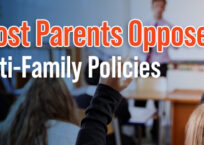An article on abstinence-only programs appearing in the Feb. 2010 issue of Archives of Pediatrics and Adolescent Medicine reports that “Only about a third of sixth- and seventh-graders who completed an abstinence-focused program started having sex within the next two years, researchers found. Nearly half of the students who attended other classes, including ones that combined information about abstinence and contraception, became sexually active. “
The authors concluded that “Theory-based abstinence-only interventions may have an important role in preventing adolescent sexual involvement.”
We can all agree that the fact that any sixth–ninth graders are having sex is unacceptable, but a decrease from 50% to 30% is significant. Why aren’t all child advocates rejoicing at this good news?
Last year, I wrote about Janet Rosenbaum’s analysis of “virginity pledges.” What was interesting in that public debate was that many critics conflated “virginity pledges” with abstinence education, treating them as if they were the same. Although virginity pledges are part of some abstinence curricula, they are not part of all abstinence curricula, and, of course, virginity pledges do not constitute abstinence curricula.
Comprehensive sex ed proselytes, giddy about Janet Rosenbaum’s findings, overlooked this discovery of Rosenbaum’s:
[T]eens who take virginity pledges do delay sexual activity until an average age of 21 (compared to about age 17 for the average American teen).
They also seemed not to notice that “Those who had taken a pledge had 0.11 fewer past-year sexual partners,” a finding which a clearly unbiased Rosenbaum dismissed, saying:
[T]his modest difference is unlikely to affect sexually transmitted disease risk, because pledgers do not differ in the average number of lifetime partners or age of sexual initiation [21.23 for pledgers and 20.73 for non-pledgers] or in empirical sexually transmitted disease prevalence.
Apparently to Rosenbaum, fewer sexual partners between the ages of 15–20 is unimportant if sexually transmitted disease risk is not reduced. I suspect many parents may disagree with her.
Some theorize that this delay is a result of religious faith since the study participants — both pledgers and non-pledgers — had similar conservative religious convictions (according to Rosenbaum, “40% were born-again believers”). Evidently, the proponents of early sexualization of children find religious faith so objectionable that they refuse to acknowledge the real possibility that faith may provide the solution to the problem of teen sex. http://www.cnn.com/2008/HEALTH/12/30/virginity.pledges/
Another interesting fact from the Rosenbaum study reported by the mainstream media, is that “non-pledgers,” meaning those who did not take virginity pledges were “2.31%” more likely to have “been paid for sex” than those who took virginity pledges. Make of that what you will.
Additional good news about abstinence education comes from The Heritage Foundation in an article titled “The Case for Maintaining Abstinence Education Funding”:
- “A study of seventh graders in northern Virginia, reported that, one year after the program, students who received abstinence education were half as likely as non-participants to initiate sexual activity.”
- “A 2008 Heritage report analyzed 21 different studies done on abstinence-based education programs. It found that in 16 of the 21 reports there were statistically significant positive results in delaying early sexual activity and initiation.”
Critics of abstinence programs point to a Mathematica Policy Research report released in April 2007 that compared the behavior of students in abstinence programs with that of students who were in comprehensive sex ed programs as evidence of the failure of abstinence programs. That study revealed the following:
- Kids in both groups (abstinence and control groups) were knowledgeable about the risks of having sex without using a condom or other form of protection.
- Condom use was not high in either group.
- By the end of the study, when the average child was just shy of 17, half of both groups had remained abstinent.
- The sexually active teenagers had sex the first time at about age 15.
- More than a third of both groups had two or more partners.
This study, however, also found this:
- A greater number of students in abstinence programs correctly identified STDs than did students in control groups.
- A greater number of students in abstinence programs reported correctly that birth control pills do not prevent STDs than did students in control groups.
After reading this report, Martha Kempner of the Sexuality Information and Education Council of the United States declared that, “Abstinence-only was an experiment and it failed.” Curiously, Ms. Kempner looked at the abstinence programs analyzed in this study, which have largely the same results as comprehensive sex ed programs–except that they better prepare students with a knowledge of STD-prevention–and she declares that only abstinence programs are failures.
I would argue that if abstinence programs are deemed a failure and worthy of defunding, then comprehensive sex ed programs, which in some studies have virtually the same results, should also be deemed a failure and defunded.
So far, the research seems to suggest that overall abstinence education works just as well — if not better — than comprehensive sex ed.

























